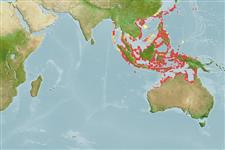>
Ovalentaria/misc (Various families in series Ovalentaria) >
Pomacentridae (Damselfishes) > Pomacentrinae
Etymology: Amphiprion: Greek, amphi = on both sides + Greek, prion, -onos = saw (Ref. 45335).
Environment: milieu / climate zone / depth range / distribution range
Ecologia
marinhas associadas(os) a recifes; não migratória; intervalo de profundidade 1 - 12 m (Ref. 7247). Tropical; 30°N - 20°S, 91°E - 143°E
Western Pacific: Gulf of Thailand to southwestern Palau, north to southern Japan, south to Java, Indonesia.
Tamanho / Peso / Idade
Maturity: Lm ? range ? - ? cm
Max length : 14.0 cm TL macho/indeterminado; (Ref. 9710)
Descrição suscinta
Chaves de identificação | Morfologia | Morfometria
Espinhos dorsais (total) : 9 - 10; Raios dorsais (total) : 16 - 18; Espinhos anais: 2; Raios anais : 13 - 15.
Found in lagoon reefs and embayment. Monogamous (Ref. 52884), protandrous hermaphrodite (Ref. 55367). Oviparous, distinct pairing during breeding (Ref. 205). Eggs are demersal and adhere to the substrate (Ref. 205). Males guard and aerate the eggs (Ref. 205). Associated with the anemone Entacmaea quadricolor (Ref. 5911). Has been reared in captivity (Ref. 35413, 35415, 35418, 35420).
Ciclo de vida ou comportamento de acasalamento
Maturidade | Reprodução | Desova | Ovos | Fecundidade | Larvas
Benthic spawner. Length at sex change = 6.6 cm TL (Ref. 55367). Oviparous, distinct pairing during breeding (Ref. 205). Eggs are demersal and adhere to the substrate (Ref. 205). Males guard and aerate the eggs (Ref. 205). Monogamous mating is observed as both obligate and social (Ref. 52884). Also Ref. 240, 7471.
Fautin, D.G. and G.R. Allen, 1992. Field guide to anemonefishes and their host sea anemones. Western Australian Museum, Francis Street, Perth. (Ref. 5911)
Status na Lista Vermelha da UICN (Ref. 130435: Version 2024-2)
Ameaça para os humanos
Harmless
Uso pelos humanos
Pescarias: espécies comerciais; Aquário: Espécies comerciais
Ferramentas
Relatórios especiais
Baixar XML
Fontes da internet
Estimates based on models
Preferred temperature (Ref.
123201): 25.4 - 29.1, mean 28.7 °C (based on 1412 cells).
Índice de diversidade filogenética (Ref.
82804): PD
50 = 0.5000 [Uniqueness, from 0.5 = low to 2.0 = high].
Bayesian length-weight: a=0.02344 (0.01134 - 0.04848), b=2.98 (2.80 - 3.16), in cm total length, based on LWR estimates for this (Sub)family-body shape (Ref.
93245).
Nível Trófico (Ref.
69278): 2.7 ±0.29 se; based on food items.
Resiliência (Ref.
120179): Elevada, tempo mínimo de duplicação da população menor que 15 meses (Preliminary K or Fecundity.).
Fishing Vulnerability (Ref.
59153): Low vulnerability (10 of 100).
Nutrients (Ref.
124155): Calcium = 98.6 [50.4, 156.3] mg/100g; Iron = 0.719 [0.433, 1.170] mg/100g; Protein = 18.3 [17.1, 19.4] %; Omega3 = 0.1 [0.1, 0.2] g/100g; Selenium = 20.7 [11.8, 39.1] μg/100g; VitaminA = 82 [23, 267] μg/100g; Zinc = 1.68 [1.14, 2.42] mg/100g (wet weight);
